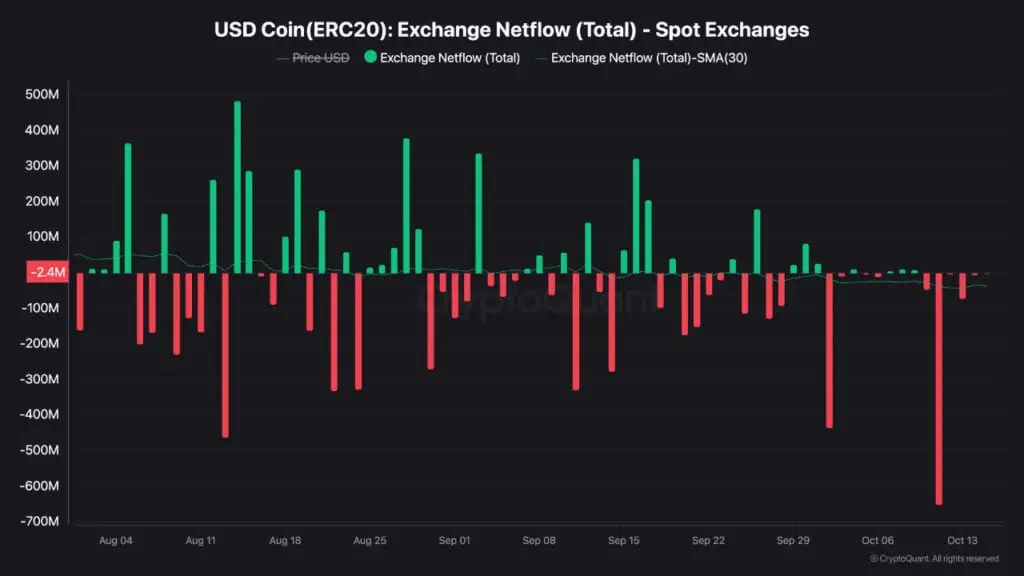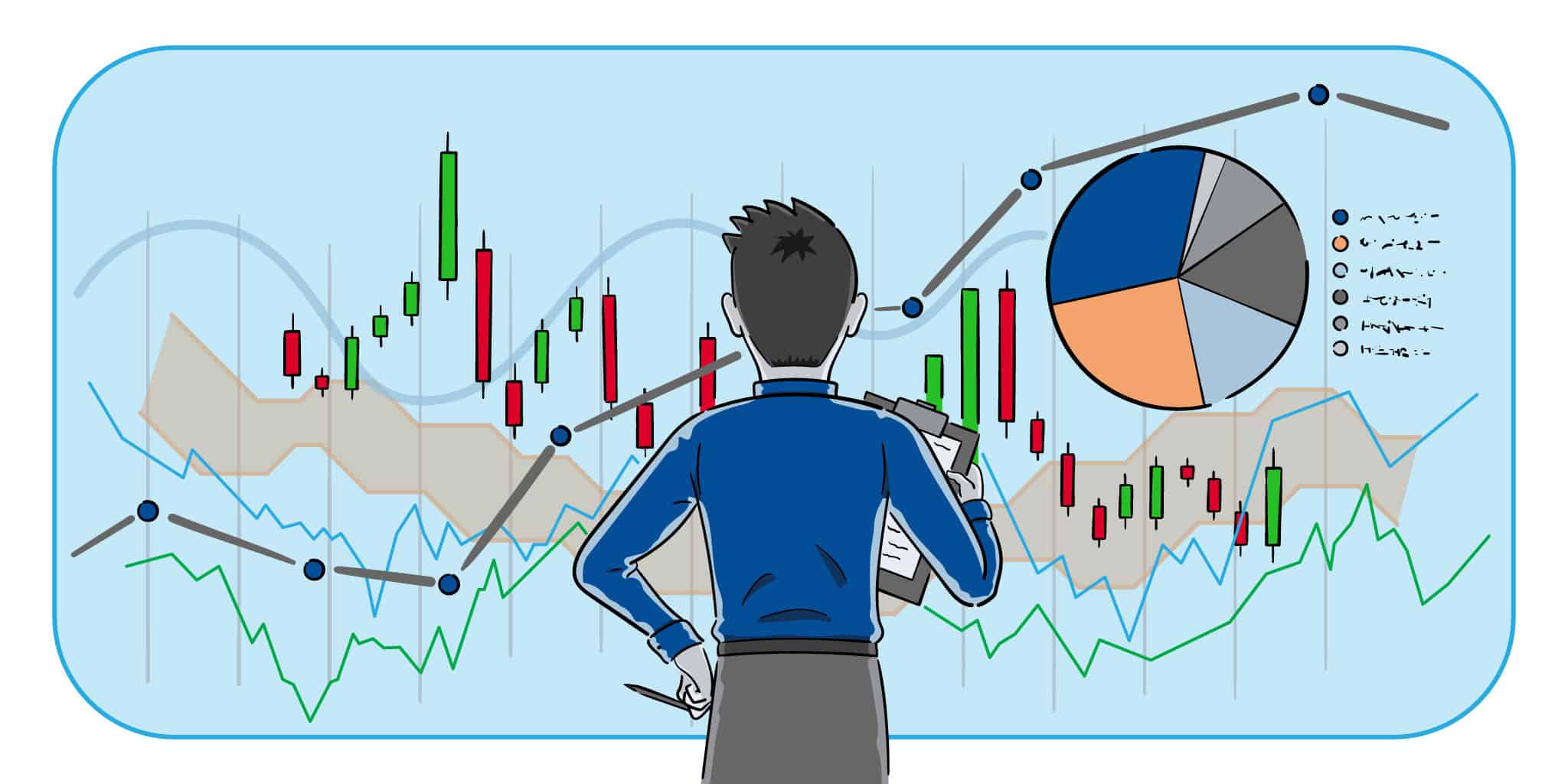
CryptoQuant analysts warn about the true nature of the recent surge in the crypto market.
The cryptocurrency market is currently undergoing a technical correction, driven in part by trade tensions between the United States and China. However, Bitcoin has shown surprising strength amid this challenging environment, something that has caught the attention of many experts. In this context, a recent report by CryptoQuant sheds light on a hidden but crucial dynamic: the current rally is not being sustained by the arrival of new capital, but by a internal liquidity rotation that feeds leveraged operations.
These experts' analysis focuses on the movements of the stablecoins USDC and USDT from early August to mid-October of this year, considered essential for the circulation of liquidity in the crypto ecosystem. What the study reveals is that these two stablecoins follow opposite trajectories: while USDC flows out of spot exchanges—places where cryptocurrencies are bought and sold directly—USDT heads toward derivatives platforms, where investors can take leveraged positions.
For CryptoQuant experts, this difference in behavior shows that the market is currently not generating new demand or attracting new money, but rather recycling existing liquidity to maintain prices. In short, the stability and recent movements of Bitcoin and other cryptocurrencies respond more to internal capital reuse strategies than to actual market expansion.
Bit2Me: direct access to the crypto market, without complicationsStablecoins are the “liquidity thermometer” of the crypto market.
Stablecoins are key instruments for measuring the health of the crypto ecosystem. They act as a bridge between fiat money and digital assets, and their performance reveals where capital is going.
The report According to CryptoQuant, the 30-day moving average of net USDC inflows into spot exchanges has been steadily declining. This means that capital intended for actual asset purchases is leaving the market. Spot liquidity, which represents direct demand for Bitcoin and other cryptocurrencies, is declining.
In parallel, net USDT flows show an opposite trend. On derivatives exchanges, this asset has seen sustained inflows, indicating that capital is being channeled into leveraged products such as futures and perpetual contracts. All this means that, rather than purchasing assets directly, investors are seeking synthetic exposure through derivative instrumentsThis liquidity migration suggests that the current price growth in cryptocurrencies is not due to organic accumulation, but rather a speculative strategy.

On the other hand, CryptoQuant analysts warn that, while this situation isn't an immediate alarm signal, it does represent a warning. They indicated that the market remains active, but its dynamism is sustained more by the reuse of existing capital than by genuine, organic expansion.
In summary, analysts noted that the current momentum of the crypto ecosystem after the correction caused by trade tensions between the United States and China comes rather from a "an engine running on the last steam", a metaphor that reflects the precariousness of current growth.
Create your account and operate crypto safely and securely.US tariffs on China hit the crypto market
CryptoQuant's analysis is being published at a time of high sensitivity for global markets. The threat of new US tariffs on Chinese products generated significant uncertainty in traditional markets. The measure weakened risk appetite, also affecting the crypto ecosystem. Bitcoin, which had surpassed $126.000 in previous days, faced a technical correction that led it to consolidate at lower levels, around $110.000.
In this environment, stablecoin flows become more important. The outflow of USDC from spot exchanges can be interpreted as a sign of caution on the part of investors. The inflow of USDT into derivatives platforms, on the other hand, reflects a search for profitability through more aggressive strategies. For experts, this combination suggests that the market is operating with more fragile liquidity, dependent on leverage and vulnerable to sudden changes in volatility.
What the behavior of capital flows reveals
CryptoQuant analysts have found that the recent surge in crypto market prices is not being driven by new capital inflows. Instead, what is happening is an internal rotation of money, with interest shifting toward cryptocurrency-related derivatives and ETFs. This movement helps sustain short-term price momentum, but does not provide a solid foundation for the rise to continue over time.
To understand this phenomenon, it is essential to distinguish between two types of liquidity: la spot liquidity and derived liquiditySpot liquidity represents actual purchases of cryptocurrencies in the market, implying a tangible flow of investment. On the other hand, derivative liquidity relates to financial contracts that mimic the asset's behavior without the need to purchase it directly. When volume is concentrated in derivatives, the risk of volatility increases considerably. Prices can experience sharp and pronounced movements, but they can also reverse quickly if sentiment or market conditions change.
In short, the current environment creates an interesting duality: on the one hand, there are reasons to be positive, as the market remains active and expanding; on the other, this dependence on complex financial mechanisms exposes the scene to latent volatility and risks that could materialize if risk appetite diminishes or if external conditions change.

Cryptocurrency Technical Analysis Course
Medium levelIn this training we have Iván González, a professional expert in investments and cryptocurrencies, to teach you how the market works and how prices affect the behavior of investors.
A signal to look beyond the price
The 2025 crypto rally has captured the attention of investors, media, and analysts. However, the CryptoQuant report invites us to look beyond the price of crypto assets.
For experts, in the current environment marked by geopolitical tensions and technical corrections, understanding how liquidity moves is critical. Stablecoins offer a clear window into capital behavior. USDC and USDT not only reflect investor preferences but also the type of exposure they seek. Thus, when liquidity shifts away from spot liquidity and focuses on derivatives, the market becomes more speculative and less structural.
Beyond price: trade with fundamentals on Bit2Me


